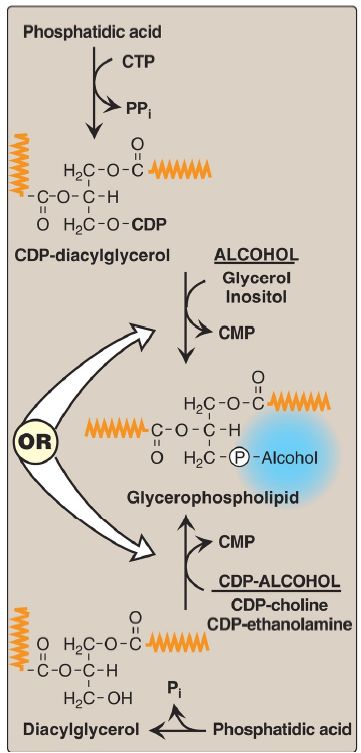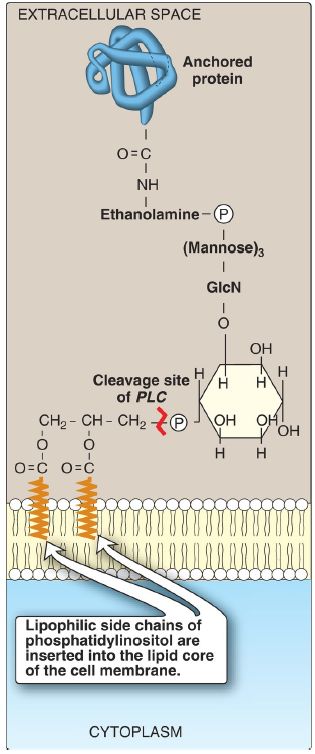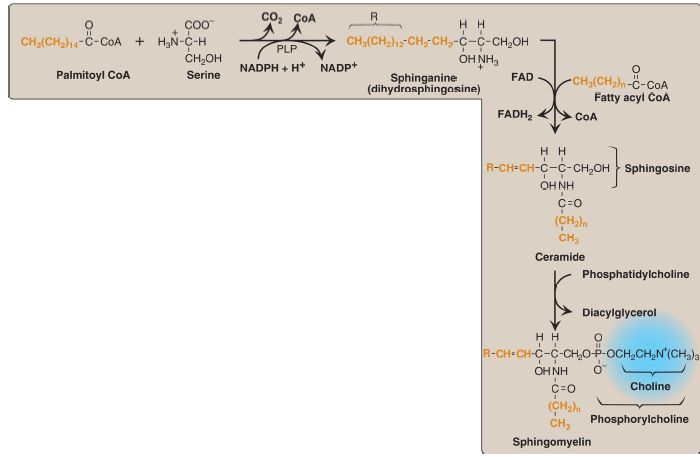
Phospholipid Synythesis
 المؤلف:
Denise R. Ferrier
المؤلف:
Denise R. Ferrier
 المصدر:
Lippincott Illustrated Reviews: Biochemistry
المصدر:
Lippincott Illustrated Reviews: Biochemistry
 الجزء والصفحة:
الجزء والصفحة:
 13-10-2021
13-10-2021
 3111
3111
Phospholipid Synythesis
Glycerophospholipid synthesis involves either the donation of PA from cytidine diphosphate (CDP)-DAG to an alcohol or the donation of the phosphomonoester of the alcohol from CDP-alcohol to DAG (Fig. 1). In both cases, the CDPbound structure is considered an activated intermediate, and cytidine monophosphate (CMP) is released as a side product. Therefore, a key concept in glycerophospholipid synthesis is activation, of either DAG or the alcohol to be added, by linkage with CDP. [Note: This is similar in principle to the activation of sugars by their attachment to uridine diphosphate (UDP).]
The FA esterified to the glycerol alcohol groups can vary widely, contributing to the heterogeneity of this group of compounds, with saturated FA typically found at carbon 1 and unsaturated ones at carbon 2. Most phospholipids are synthesized in the smooth endoplasmic reticulum (SER). From there, they are transported to the Golgi and then to membranes of organelles or the plasma membrane or are secreted from the cell by exocytosis. [Note: Ether lipid synthesis from dihydroxyacetone phosphate begins in peroxisomes.]

Figure 1: Glycerophospholipid synthesis requires activation of either diacylglycerol or an alcohol by linkage to cytidine diphosphate (CDP). CMP and CTP = cytidine mono- and triphosphates; Pi = inorganic phosphate; PPi = pyrophosphate. ( is a fatty acid hydrocarbon chain.)
A. Phosphatidic acid
PA is the precursor of other glycerophospholipids. The steps in its synthesis from glycerol 3-phosphate and two fatty acyl coenzyme A (CoA) molecules , in which PA is shown as a precursor of triacylglycerol (TAG). Essentially all cells except mature erythrocytes can synthesize phospholipids, whereas TAG synthesis occurs essentially only in the liver, adipose tissue, lactating mammary glands, and intestinal mucosal cells.
B. Phosphatidylcholine and phosphatidylethanolamine
The neutral phospholipids PC and PE are the most abundant phospholipids in most eukaryotic cells. The primary route of their synthesis uses choline and ethanolamine obtained either from the diet or from the turnover of the body’s phospholipids. [Note: In the liver, PC also can be synthesized from PS and PE (see 2. below).]
1. Synthesis from preexisting choline and ethanolamine: These synthetic pathways involve the phosphorylation of choline or ethanolamine by kinases, followed by conversion to the activated form, CDP-choline or CDP-ethanolamine. Finally, choline phosphate or ethanolamine phosphate is transferred from the nucleotide (leaving CMP) to a molecule of DAG (see Fig. 1).
a. Significance of choline reutilization: The reutilization of choline is important because, although humans can synthesize choline de novo, the amount made is insufficient for our needs. Thus, choline is an essential dietary nutrient with an adequate intake of 550 mg for men and 425 mg for women. [Note: Choline is also used for the synthesis of acetylcholine, a neurotransmitter.]
b. Phosphatidylcholine in lung surfactant: The pathway described above is the principal pathway for the synthesis of dipalmitoylphosphatidylcholine (DPPC or, dipalmitoyl lecithin). In DPPC, positions 1 and 2 on the glycerol are occupied by palmitate, a saturated LCFA. DPPC, made and secreted by type II pneumocytes, is a major lipid component of lung surfactant, which is the extracellular fluid layer lining the alveoli. Surfactant serves to decrease the surface tension of this fluid layer, reducing the pressure needed to reinflate alveoli, thereby preventing alveolar collapse (atelectasis). [Note: Surfactant is a complex mixture of lipids (90%) and proteins (10%), with DPPC being the major component for reducing surface tension.]
Fetal lung maturity can be gauged by determining the DPPC/sphingomyelin ratio, usually written as L (for lecithin)/S, in amniotic fluid. A value ≥2 is evidence of maturity, because it reflects the shift from sphingomyelin to DPPC synthesis that occurs in pneumocytes at ~32 weeks’ gestation.
c. Lung maturity: Respiratory distress syndrome (RDS) in preterm infants is associated with insufficient surfactant production and/or secretion and is a significant cause of all neonatal deaths in Western countries. Lung maturation can be accelerated by giving the mother glucocorticoids shortly before delivery to induce expression of specific genes. Postnatal administration of natural or synthetic surfactant (by intratracheal instillation) is also used. [Note: Acute RDS, seen in all age groups, is the result of alveolar damage (due to infection, injury, or aspiration) that causes fluid to accumulate in the alveoli, impeding the exchange of oxygen (O2) and carbon dioxide (CO2).]
2. Phosphatidylcholine synthesis from phosphatidylserine: The liver requires a mechanism for producing PC, even when free choline levels are low, because it exports significant amounts of PC in the bile and as a component of plasma lipoproteins. To provide the needed PC, PS is decarboxylated to PE by PS decarboxylase. PE then undergoes three methylation steps to produce PC, as illustrated in Figure 2. Sadenosylmethionine is the methyl group donor .

Figure 2: Synthesis of phosphatidylcholine from phosphatidylserine in the liver. ( is a fatty acid hydrocarbon chain.) = phosphate; CO2 = carbon dioxide.
C. Phosphatidylserine
PS synthesis in mammalian tissues is provided by the base exchange reaction, in which the ethanolamine of PE is exchanged for free serine (see Fig. 2). This reaction, although reversible, is used primarily to produce the PS required for membrane synthesis. PS has a net negative charge.
D. Phosphatidylinositol
PI is synthesized from free inositol and CDP-DAG, as shown in Figure 1. PI is an unusual phospholipid in that it most frequently contains stearic acid on carbon 1 and arachidonic acid on carbon 2 of the glycerol.
Therefore, PI serves as a reservoir of arachidonic acid in membranes and, thus, provides the substrate for prostaglandin synthesis when required. Like PS, PI has a net negative charge. [Note: There is asymmetry in the phospholipid composition of the cell membrane. PS and PI, for example, are found primarily on the inner leaflet. Asymmetry is achieved by ATP-dependent enzymes known as “flippases” and “floppases.”]
1. Role in signal transduction across membranes: The phosphorylation of membrane-bound PI produces polyphosphoinositides such as phosphatidylinositol 4,5-bisphosphate ([PIP2]; Fig. 3). The cleavage of PIP2 by phospholipase C occurs in response to the binding of various neurotransmitters, hormones, and growth factors to G protein–coupled receptors (GPCR), such as the α1 adrenergic receptor, on the cell membrane and activation of the Gq α-subunit (Fig. 4). The products of this cleavage, inositol 1,4,5-trisphosphate (IP3) and DAG, mediate the mobilization of intracellular calcium and the activation of protein kinase C, which act synergistically to evoke specific cellular responses. Signal transduction across the membrane is, thus, accomplished.

Figure 3: Structure of phosphatidylinositol 4,5-bisphosphate (PIP2). Cleavage by phospholipase C produces inositol 1,4,5-trisphosphate (IP3) and diacylglycerol. ( is a fatty acid hydrocarbon chain.) = phosphate.

Figure 4: Role of inositol triphosphate and diacylglycerol in cell signaling. GDP and GTP = guanosine di- and triphosphates; Ca2+ = calcium.
2. Role in membrane protein anchoring: Specific proteins can be covalently attached through a carbohydrate bridge to membrane-bound PI (Fig. 5). For example, lipoprotein lipase, an enzyme that degrades triacylglycerol in lipoprotein particlesis attached to capillary endothelial cells by a glycosyl phosphatidylinositol (GPI) anchor. [Note: GPI-linked proteins are also found in a variety of parasitic protozoans, such as trypanosomes and leishmania.] Being attached to a membrane lipid (rather than being an integral part of the membrane) allows GPI-anchored proteins increased lateral mobility on the extracellular surface of the plasma membrane. The protein can be cleaved from its anchor by the action of phospholipase C (see Fig. 5).
[Note: A deficiency in the synthesis of GPI in hematopoietic cells results in the hemolytic disease paroxysmal nocturnal hemoglobinuria, because GPI-anchored proteins protect blood cells from complement-mediated lysis.]

Figure 5: Example of a glycosyl phosphatidylinositol (GPI) membrane protein anchor. GlcN = glucosamine; = phosphate; PLC = phospholipase C.
E. Phosphatidylglycerol and cardiolipin
Phosphatidylglycerol occurs in relatively large amounts in mitochondrial membranes and is a precursor of cardiolipin (diphosphatidyglycerol). It is synthesized from CDP-DAG and glycerol 3-phosphate. Cardiolipin is synthesized by the transfer of DAG 3-phosphate from CDPDAG to a pre-existing molecule of phosphatidylglycerol.
F. Sphingomyelin
Sphingomyelin, a sphingosine-based phospholipid, is found in cell membranes and in the myelin sheath. The synthesis of sphingomyelin is shown in Figure 6. Briefly, palmitoyl CoA condenses with serine, as CoA and the carboxyl group (as CO2) of serine are lost. [Note: This reaction, like the decarboxylation reactions involved in the synthesis of PE from PS and of regulators from amino acids (for example, the catecholamines from tyrosine), requires pyridoxal phosphate (a derivative of vitamin B6) as a coenzyme.] The product is reduced in a nicotinamide adenine dinucleotide phosphate (NADPH)-requiring reaction to sphinganine (dihydrosphingosine). The sphinganine is acylated at the amino group with one of a variety of LCFA and then desaturated to produce a ceramide, the immediate precursor of sphingomyelin .

Figure 6: Synthesis of sphingomyelin. PLP = pyridoxal phosphate; NADP(H) = nicotinamide adenine dinucleotide phosphate; FAD(H2) = flavin adenine dinucleotide; CoA = coenzyme A.
Ceramides play a key role in maintaining the skin’s water-permeability barrier. Decreased ceramide levels are associated with a number of skin diseases.
Phosphorylcholine from PC is transferred to the ceramide, producing sphingomyelin and DAG. [Note: Sphingomyelin of the myelin sheath contains predominantly longer-chain FA such as lignoceric acid and nervonic acid, whereas gray matter of the brain has sphingomyelin that contains primarily stearic acid.]
 الاكثر قراءة في الكيمياء الحيوية
الاكثر قراءة في الكيمياء الحيوية
 اخر الاخبار
اخر الاخبار
اخبار العتبة العباسية المقدسة


